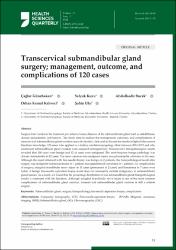Transcervical submandibular gland surgery; management, outcome, and complications of 120 cases
Citation
Günebakan, Ç., Selçuk, K. U. Z. U., Bucak, A., Kahveci, O. K., & Şahin, U. L. U. (2022). Transcervical submandibular gland surgery; management, outcome, and complications of 120 cases. Health Sciences Quarterly, 2(1), 11-15.Abstract
Surgical intervention is the treatment procedure of many diseases of the submandibular gland such as sialolithiasis, chronic sialoadenitis, and tumors. This study aims to analyze the management, outcomes, and complications of transcervical submandibular gland excision cases of a tertiary clinic and to discuss the results in light of the current literature knowledge. 120 cases who applied to a tertiary otorhinolaryngology clinic between 2014-2019 and who underwent submandibular gland excision were analyzed retrospectively. Postoperative histopathological results revealed that 108 cases were benign and 12 of cases were malignant. The most frequent benign pathology was chronic sialoadenitis in 82 cases. The most common non-malignant tumor was pleomorphic adenoma in 16 cases. Although the result obtained with fine-needle-biopsy was benign in 2 patients, the histopathological result after surgery was malignant (adenocarcinoma in 1 patient, mucoepidermoid carcinoma in 1 patient). As complications of surgery; marginal mandibular nerve injury in 11 cases (permanent in 2 cases) and hematoma in 7 cases were noted. A benign fine-needle aspiration biopsy result does not necessarily exclude malignancy in submandibular gland masses. As a result, we found that the percentage distribution of our submandibular gland histopathological results is consistent with the literature. Although marginal mandibular nerve injury is one of the most common complications of submandibular gland excision, transcervical submandibular gland excision is still a reliable surgery.
















